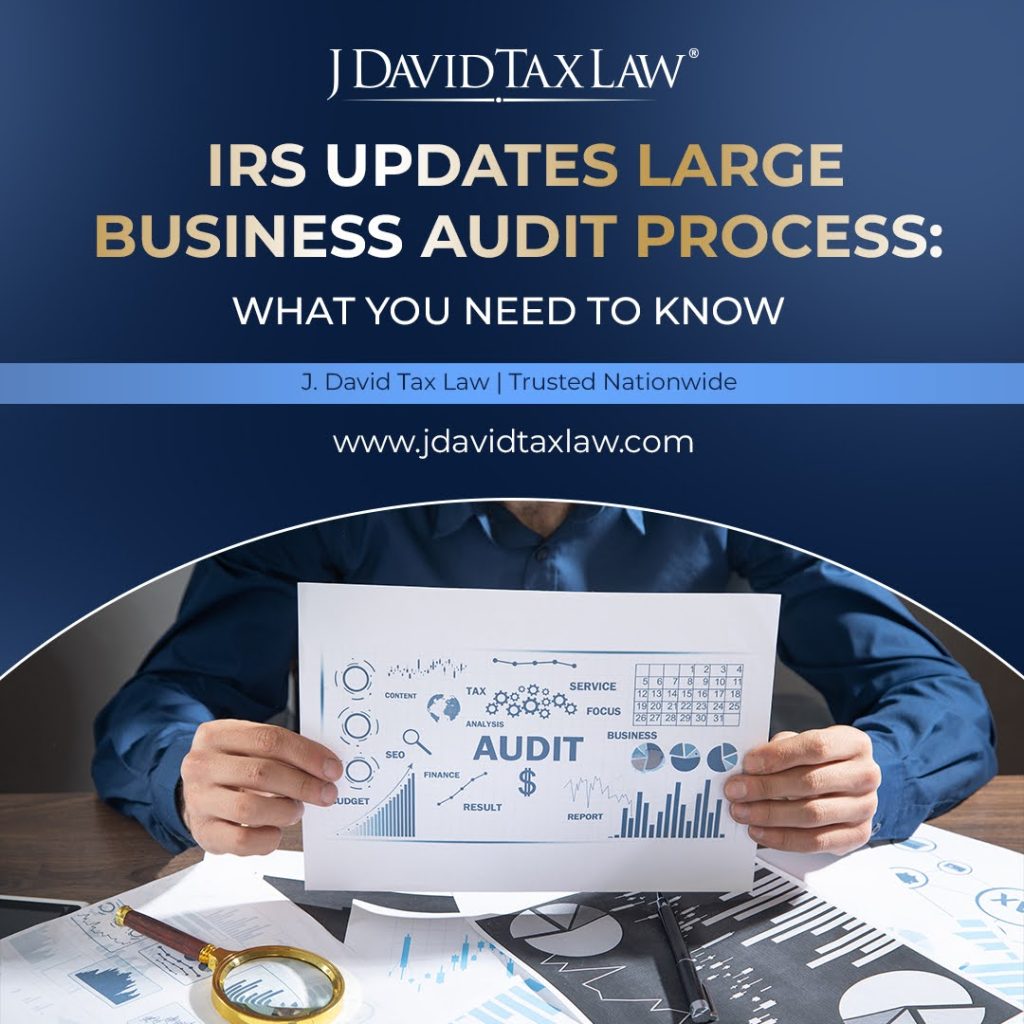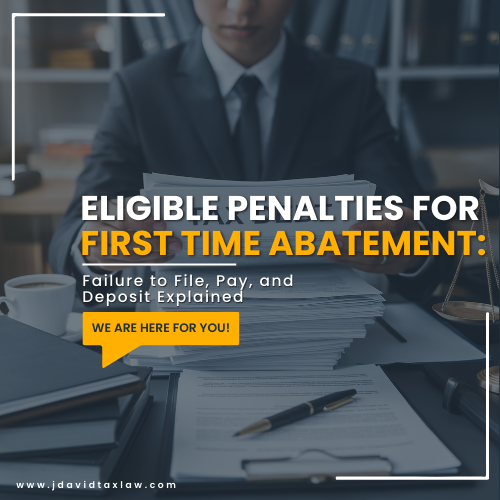What If I Owe $100,000 or More in Back Taxes? Your IRS Relief Options Explained
Owing $100,000 or more in back taxes to the IRS is more common than most people think, but that doesn’t make it any less overwhelming. Whether it stemmed from years of unfiled returns, unexpected audits, or underpayment by self-employed individuals, six-figure tax debt puts taxpayers directly in the crosshairs of the IRS.
When balances cross $100K, the IRS doesn’t just send more letters, it initiates aggressive enforcement. That includes wage garnishments, bank account levies, property liens, and even passport revocation for unresolved balances above the federal threshold. And because of automated enforcement systems, action can be triggered quickly and without further warning.
This guide explains exactly what happens when you owe the IRS over $100,000, and what you can do about it. You’ll learn about the most effective IRS tax debt relief programs, how notices escalate, and why professional legal help matters.
If you’ve received a notice or are concerned about possible collection action, don’t wait. The earlier you act, the more options are on the table.
What Happens When You Owe the IRS $100,000+
The IRS labels any tax debt over $62,000 (adjusted yearly for inflation and inclusive of penalties and interest) as “seriously delinquent tax debt” (>$62,000 incl. penalties/interest), sets off a chain of serious enforcement actions, especially if the taxpayer fails to address it promptly.
Here’s what can hEappen:
Wage Garnishment
The IRS doesn’t need a court order to start taking your paycheck. Once a final notice is sent and ignored, the IRS can garnish wages directly from your employer. They follow Publication 1494, which outlines the portion of income protected based on filing status and number of dependents. The rest can be taken, every pay period, until the debt is resolved or a formal relief agreement is made.
Bank Levy
A bank levy allows the IRS to freeze and seize funds directly from your bank account. The money is held for 21 days, giving you a narrow window to respond. If unresolved, the funds are removed and applied to your balance.
Federal Tax Lien
A tax lien is the IRS’s legal claim to your property, including real estate, vehicles, and financial assets. While it doesn’t mean immediate seizure, it can still block sales or refinancing until addressed.
Note: IRS liens no longer appear on credit reports per Experian, Equifax, and TransUnion (since 2018), but they still impact financial transactions especially with lenders, landlords, or insurers.
Passport Revocation
Under the FAST Act, the IRS can certify seriously delinquent debt to the State Department, which may deny passport renewal or revoke an active passport. This can disrupt personal travel, business trips, or even immigration status for non-citizens.
Why It Happens Fast Now
Modern IRS enforcement is driven by automated systems. Instead of waiting for an agent to review your case, the IRS uses data matching, system flags, and notice cycles to escalate cases rapidly.
A balance over $100K often triggers higher scrutiny, more aggressive notices, and faster movement toward garnishment or liens. Once your debt is labeled “seriously delinquent,” your options shrink, and your financial life is at risk of being frozen.
IRS Notices You’ll Receive
When you owe the IRS over $100,000, your case typically follows a structured sequence of notices before aggressive collection action begins. These notices are not optional reading, they’re legal warnings, and ignoring them can quickly lead to levies, garnishments, and liens.
Here’s what CP14, CP501, CP503, CP504, and LT11 notices each one means:
CP14 – Balance Due Notice
This is your first formal alert. It shows your tax balance, penalties, and interest. While it may seem routine, it marks the official start of the collection process. Most taxpayers ignore CP14, but acting early here opens up the most flexible options.
CP501 / CP503 – Reminder Notices
These are mailed if the balance remains unpaid after CP14. While less intimidating, they still signal that your case is progressing. CP503 typically includes stronger language and shorter timeframes to respond.
CP504 – Intent to Levy Notice
This notice means the IRS is preparing to levy your state tax refund and may pursue more aggressive collection methods. It also warns that a federal tax lien could be filed against your property.
LT11 – Final Notice Before Enforcement
This is the most critical stage. LT11 (or sometimes Letter 1058) is your final warning before wage garnishment, bank levy, or seizure begins. Once issued, you only have 30 days to request a Collection Due Process (CDP) hearing or seek relief before action starts.
Don’t Wait for Enforcement
By the time you receive LT11, options like Offer in Compromise, payment plans, or hardship status may be harder to access. The IRS has built-in authority to proceed without further notice if you don’t respond.
Key Takeaway
The earlier you act, especially after CP14 or CP504, the more leverage you’ll have. Ignoring these notices doesn’t delay enforcement. It accelerates it.
Why You Shouldn’t Handle This Alone
If you owe more than $50,000, your tax situation is no longer just a matter of payment, it becomes a legal issue that requires strategy, negotiation, and complete financial transparency. At this level, the IRS will not approve relief without full documentation of your income, assets, and expenses.
Many taxpayers attempt to go it alone, but here’s what can happen:
You may overpay thousands because you don’t know how to legally reduce your “reasonable collection potential.”
You risk denied applications for an Offer in Compromise or installment agreement because of simple errors or missing forms.
You might receive a wage garnishment or bank levy before the IRS ever reviews your request, because it wasn’t submitted the right way.
And unlike CPAs or tax preparers, only tax attorneys are authorized to:
Speak directly with the IRS on your behalf using Form 2848 Power of Attorney
Submit legal relief strategies like Currently Not Collectible status, Penalty Abatement, or an OIC appeal
Intervene immediately to stop enforced collections such as garnishments, often within 24 to 48 hour
The IRS is Forgiving Millions Each Day. You Could Be Next.
IRS Relief Options for $100,000+ Tax Debt
Once your balance hits six figures, the IRS expects full financial disclosures and offers several legal avenues for relief. But not all relief is equal , and qualifying depends on your income, assets, filing history, and ability to pay. Here’s a breakdown of the most common solutions used to resolve $100,000 or more in IRS back taxes.
1. Installment Agreements (Standard or Extended)
This is the most common IRS resolution method : a structured plan to pay your full tax debt in monthly installments .
-
You apply using Form 9465 along with a detailed financial disclosure via Form 433-A (for individuals) or 433-B (for businesses).
-
For balances over $50,000, the IRS requires verified financial data including income, household expenses, and equity in assets.
-
Standard agreements run up to 72 months , but extended terms may stretch to 84–120 months in some hardship cases.
Important: The IRS may file a Notice of Federal Tax Lien to protect its interest especially if your debt is large or assets are involved. While this doesn’t mean immediate seizure, it can impact your credit and ability to sell property.
This option is ideal for taxpayers with steady, reliable income who can afford monthly payments but not a lump sum.
2. Partial Payment Installment Agreement (PPIA)
If you can’t afford to pay the full amount even over time a PPIA allows you to pay what you reasonably can , and the IRS agrees not to pursue the rest as long as you’re compliant.
This solution works best for those with low or fluctuating income , or limited assets that prevent a full payoff.
-
Lower monthly payments are based on your current financial ability, not the total debt owed.
-
The IRS periodically re-evaluates your situation, usually every two years , to see if you can afford to pay more.
-
If your financial situation doesn’t improve before the 10-year Collection Statute Expiration Date (CSED) , the remaining debt may expire without full payment.
3. Offer in Compromise (OIC)
An OIC lets you settle your IRS debt for less than the full amount owed, sometimes significantly less. But approval is rare without proper legal guidance and financial documentation.
-
You submit Form 656 along with Form 433-A (OIC) for individuals or 433-B (OIC) for businesses.
-
You must be current on all required tax filings and estimated payments before applying.
There are three types of OIC:
-
Doubt as to Collectibility (DATC): You simply can’t afford to pay what you owe.
-
Doubt as to Liability (DATL): You don’t believe the debt is accurate.
-
Effective Tax Administration (ETA): You technically can pay, but doing so would cause serious hardship (e.g., elderly or disabled individuals with medical expenses).
4. Currently Not Collectible (CNC) Status
If you’re in serious financial distress , the IRS may pause all collection actions— no garnishments, no levies, no asset seizures .
To qualify:
-
You must submit a full financial disclosure, typically via Form 433-A or 433-F .
-
You must show that paying your IRS debt would leave you unable to cover necessary living expenses (rent, food, healthcare, etc.).
CNC is not permanent . The IRS reviews your status periodically. If your financial situation improves, collection efforts may resume.
Many use CNC as a temporary relief strategy while preparing an OIC or gathering funds to begin an installment plan.
5. Penalty Abatement
Penalties can quickly add tens of thousands of dollars to an already high tax bill. Fortunately, the IRS offers two main ways to eliminate them:
-
First-Time Abatement (FTA): If you’ve filed and paid on time in the last three years, you may qualify.
-
Reasonable Cause Relief: You must show a valid reason for falling behind—such as a serious illness , natural disaster , military deployment , or death in the family .
You’ll typically request penalty abatement using Form 843 (Claim for Refund and Request for Abatement ) , which supports both FTA and Reasonable Cause claims. Including this with supporting documentation can improve approval chances.
Supporting documentation is key. Medical records, legal notices, or disaster declarations strengthen your case. While abatement doesn’t reduce your base tax balance, it can shave thousands off the total owed , making it easier to negotiate or pay off through other programs.
|
Program |
Best For |
Monthly Payments |
Total Debt Reduced |
Collection Stops |
|
Standard Installment Agreement |
Steady earners |
Yes |
No |
No |
|
Partial Payment Installment |
Low/unpredictable income |
Yes (lower) |
Maybe (if CSED ends) |
No |
|
Offer in Compromise (OIC) |
Financial hardship, low equity |
Possibly |
Yes |
Yes (if accepted) |
|
Currently Not Collectible (CNC) |
Temporary extreme hardship |
No |
No |
Yes |
|
Penalty Abatement |
First-time mistakes or major setbacks |
Depends |
No (just penalties) |
No |
What If You Haven’t Filed Yet?
If you haven’t filed one or more years of tax returns, the IRS won’t just wait around—they’ll file one for you.
This is called a Substitute for Return (SFR) . It’s the IRS’s version of your tax return, and it’s usually not in your favor . They use income data from W-2s, 1099s, or other reports—but they won’t include any deductions, exemptions, or credits you may be entitled to. That means the resulting tax bill is often much higher than it should be.
In addition to the inflated balance, you’ll be hit with the failure-to-file penalty , which is:
-
5% of the unpaid tax per month , up to a maximum of 25%
If you owe $100,000+, that penalty alone can add over $25,000 to your total balance in just a few months.
Filing your missing returns, even late, comes with two major benefits:
-
You get to correct the record , lowering your actual liability
-
Collection efforts may pause while your filings are being reviewed
IRS Collection Timeline: How Fast Things Escalate
If you think the IRS moves slowly—you’d be wrong. When you owe $100,000 or more , the clock starts ticking the moment your return is processed or a balance is assessed. Enforcement begins with a letter, but it rarely ends there.
Here’s how fast things can escalate if you don’t act:
Now Is the Time to Take Legal Action on Your Tax Debt
If you owe six figures, the IRS won’t wait and you can’t afford to either. The moment your balance crosses $100,000, you’re flagged for aggressive enforcement. These cases are too serious for general financial help or DIY responses.
At J. David Tax Law® , our IRS tax attorneys act fast to protect your income, negotiate directly with federal and state agencies, and match you with the right relief path. Whether you qualify for an Offer in Compromise , Partial Payment Plan , or Currently Not Collectible status, we build a legal strategy aligned with your financial reality and rights.
Call (888) 789-5011 for a free, confidential consultation and take the first step toward permanent resolution.
Conclusion
When your IRS tax debt reaches six figures, it’s no longer just a paperwork issue, it’s a legal and financial emergency. The IRS treats balances over $100,000 as high-risk, and their systems are built to act quickly. Levies, liens, and even passport revocation can happen faster than most people expect.
The good news? You don’t have to face it alone, and you still have options. Whether it’s negotiating a payment plan, pursuing a settlement through an Offer in Compromise, or proving financial hardship, the key is taking action before enforcement begins.
The earlier you step in, the more control you have over the outcome. Waiting too long may lead to consequences that could have been avoided with the right guidance.
Frequently Asked Questions
Can I negotiate a $100,000 IRS tax bill?
Yes, you can negotiate a $100,000 IRS tax bill. The IRS offers several relief programs such as Installment Agreements, Partial Payment Installment Agreements, and Offers in Compromise that may allow you to reduce your balance or pay over time. The key is providing full financial disclosure and showing that the debt is unaffordable under current circumstances.
Will the IRS take my house if I owe six figures?
Can I qualify for an Offer in Compromise with $100,000+ in tax debt?
Will the IRS revoke my passport if I owe back taxes?
The IRS can revoke your passport if you owe back taxes exceeding $62,000 (including penalties and interest). This is part of the FAST Act enforcement. If your debt qualifies, the IRS may certify it to the State Department, which can deny passport issuance or renewal.
How quickly can IRS wage garnishments be stopped?
IRS wage garnishments can often be stopped in 24 to 48 hours once a relief request is submitted and accepted. The IRS typically halts garnishments after a legal representative steps in with an approved resolution like an installment plan, Offer in Compromise, or hardship claim.




















